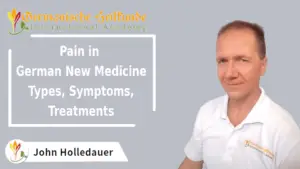
The worst pain we know of is caused by bone in the healing phase. The patient begs for morphine, nothing else helps with bone pain, but no one survives.
No one has ever died from pain, but everyone dies from morphine. So, what to do? In this video, you’ll learn.
In today’s supposedly modern medicine, we have the opinion that suffering from pain is no longer necessary and that one has the right to painkilling medication for the slightest hint of pain.
There are many different painkilling drugs with different effects. I would like to discuss one drug in more detail: morphine.
Bone cancer patients apparently have the worst pain. The bone is recalcified under swelling in the healing phase after a self-devaluation conflict. The periosteum stretches and expands to the point of crisis. The crisis generally has the task of preventing the fall into vagotonia and steering the organism back toward health. The urinary flood phase begins with the crisis.
The previously stored water is now squeezed out again from the swelling, and the pain subsides. The brutal pain occurs in the healing phase before the crisis. With the bone, you can also calculate quite accurately:
For example, if one was active in conflict for four weeks, the pain comes for 14 days and goes again for 14 days. After a resolved biting conflict, the pain in the tooth bone is commonly known.
What helps against toothache? Almost nothing; you have to go through it.
With the tooth, you have the pain punctually. But if the entire pelvis or the spine goes into solution, then this pain is almost unbearable.
In conventional medicine, cancer is considered incurable. If the bone cancer patient complains about pain, he gets, of course, morphine. Nothing else helps with the bone.
From the point of view of understanding, it is essential to know that pain is not an objective, but a subjective quantity. There is also no measuring device that could measure pain intensity.
This subjective quantity can be seen very well in the case of a child who has hurt himself a little and runs crying to his mother. The mother puts her hand on the slight injury or blows gently on it once, speaks a few soothing words, and the child runs on again to continue playing.
Now, when the bone cancer patient enters the healing phase, the pain gets worse and worse. But there is no such thing as a healing phase in cancer in conventional medicine.
One now associates pain with cancer, which becomes worse and worse. In reality, the bone is repairing itself!
The deeper the patient gets into healing, the more pain he feels, the more he despairs, and the more he demands morphine.
If one understands the Germanische Heilkunde, one is happy about the solved self-devaluation conflict. Because you have to solve this conflict; otherwise, the bone will dissolve.
And it is better to resolve this conflict today than tomorrow. Tomorrow you have even more conflict load.
If you can now estimate the conflict load, then you can make a calendar: 4 weeks I was conflict active, one week of pain I already have behind me, a violent week still comes up to the crisis, then the pain will subside.
Just by this understanding alone, one has subjectively less agony. The knowledge of these correlations is the best painkiller of all!
Similarly to the woman giving birth, she also has pain, but she also knows that she will hold her baby in her hands after the birth.
We, in Germanische Heilkunde, are often accused of making patients suffer. This is nonsense! Nobody considers the fatal effect of morphine, which I would like to explain now.
In the deepest vagotonia, when the pain is greatest, the edema in the brain is greatest. Morphine has a powerful sympathicotonic effect. The patient is lifted with morphine from the deepest vagotonia into sympathicotonia in the shortest time. And in sympathicotonia, there is no edema in the brain.
Dr. Hamer explains: the brain relay is expanded due to the edema storage, giving morphine forces the edema to hum into itself like a taut rubber band, and the patients die a brain death.
Just like the so-called golden shot in the addict. Once the addict has a healing phase with edema in the brain, and if he injects the same dose as always. But now, with the edema in the brain, this dose is too much.
The use of morphine in case of an injury, for example, if one has cut off his finger, does not have this fatal effect. In the case of an accident, there is usually no edema in the brain. In conventional cancer therapy, morphine is the beginning of the end.
It is claimed that in cancer, nothing more can be done, but to suffer pain, but patients do not have to, so they are put to sleep with morphine. Some even think they are doing the patient some good. Morphine also robs any morale!
When the effect of the morphine subsides, the pain returns with a perceived greater intensity, and the patient screams for even more morphine.
But especially in such a painful healing phase, the patient must not be robbed of his will, but we must strengthen his belief in recovery.
I know many bone cancer patients who have come through their healing without morphine and, for that very reason, are still alive today.
I hardly know any cancer patients who have been able to recover after using morphine. In fact, I don’t know a single one.
The morphine paralyzes the bowels, and with morphine the pain immediately vanishes.
You think, “Ah, this is real relief.”
But people push the healing phase forward like a wall of water. At some point, the effect of the morphine wears off, and the pain sets in again. Then you reach for the morphine again, and the bowels are paralyzed again.
Then there are two possibilities only, you starve to death because the intestine remains paralyzed by the morphine, or you endure the pain.
Once one has taken morphine, one hardly gets rid of it. That’s devil’s stuff.
In conclusion: One does not die from the pain. But from morphine and very quickly!
To be able to have therapeutic success, one must build on natural biological laws. If we acts against natural biological laws, then we suffers.
Have fun with the further study of the Germanische Heilkunde, and goodbye
until the following video.












Copyright © 2024 by GHk Online Service, LLC
| Cookie | Duration | Description |
|---|---|---|
| cookielawinfo-checkbox-analytics | 11 months | This cookie is set by GDPR Cookie Consent plugin. The cookie is used to store the user consent for the cookies in the category "Analytics". |
| cookielawinfo-checkbox-functional | 11 months | The cookie is set by GDPR cookie consent to record the user consent for the cookies in the category "Functional". |
| cookielawinfo-checkbox-necessary | 11 months | This cookie is set by GDPR Cookie Consent plugin. The cookies is used to store the user consent for the cookies in the category "Necessary". |
| cookielawinfo-checkbox-others | 11 months | This cookie is set by GDPR Cookie Consent plugin. The cookie is used to store the user consent for the cookies in the category "Other. |
| cookielawinfo-checkbox-performance | 11 months | This cookie is set by GDPR Cookie Consent plugin. The cookie is used to store the user consent for the cookies in the category "Performance". |
| viewed_cookie_policy | 11 months | The cookie is set by the GDPR Cookie Consent plugin and is used to store whether or not user has consented to the use of cookies. It does not store any personal data. |
You’ll be informed by email when we post new articles and novelties. In every email there is a link to modify or cancel your subscription.